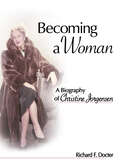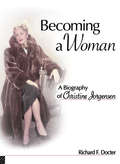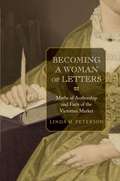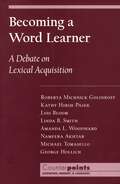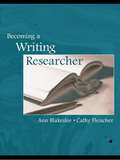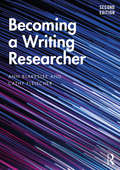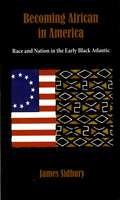- Table View
- List View
Becoming a Wildlife Professional
by Scott E. Henke Paul R. KrausmanWorking with wildlife can be a thrilling adventure steeped in the wonders of the natural world, but entering the field demands a strong personal commitment. With proper training and guidance, students can transform themselves into competitive applicants and forge successful careers. This book reveals the best way to become a wildlife management professional. Becoming a Wildlife Professional is the first comprehensive book to describe the entry-level jobs available for the next generation of wildlife biologists and conservationists. Scott E. Henke and Paul R. Krausman include detailed chapters on how students should prepare for a vocation in the wildlife profession while offering pragmatic advice about applying for and obtaining a job. The core of the book presents over 100 diverse career options that are available to aspiring wildlife workers, including work in biological field research, forestry, rehabilitation, ranching, photography, and refuge management. It also details each position;€™s educational and technical requirements, challenges, salaries, and opportunities for advancement.Bringing together useful advice from a range of seasoned experts who actually hold these jobs and have used these techniques to secure employment, Becoming a Wildlife Professional conveys important philosophical messages about the responsibilities and challenges of a career in wildlife conservation and management. This how-to manual is an essential text for wildlife science students interested in making themselves marketable for employers across a wide spectrum of wildlife jobs. Chapter Author Contributors: Rick Baydack, Jessica L. Blickley, Monika Burchette, Shawn Cleveland, Kristy Deiner, Kelly Garbach, Ashley R. Gramza, Jim Heffelfinger, Scott E. Henke, Fidel Hern;¡ndez, Serra J. Hoagland, Jessica A. Homyack, Winifred B. Kessler, Holley Kline, Lianne Koczur, Michel T. Kohl, John L. Koprowski, Blaise Korzekwa, Paul R. Krausman, Iara Lacher, Mariah H. Meek, Kelly F. Millenbah, Karen E. Munroe, Kerry L. Nicholson, John P. O;€™Loughlin, Lindsey Phillips, Lauren M. Porensky, William F. Porter, Terra Rentz, Nova J. Silvy, Kelley M. Stewart, Marit L. Wilkerson, Eric Winford. An additional 52 wildlife professionals describe the work of the profession.
Becoming a Woman: A Biography of Christine Jorgensen
by Richard Docter FDiscover the remarkable woman behind the legend.Discover Christine Jorgensen’s remarkable, inspirational journey to become the woman she always knew she should have been. Becoming a Woman: A Biography of Christine Jorgensen provides fascinating insights about the woman who opened doors—and minds—on behalf of sexual minorities. This book chronicles Christine’s drive, ability to solve problems, immense determination, and just plain luck as she transformed herself into her true gender—and reveals facets of her personality previously undisclosed by other biographies of her life.Christine Jorgensen was a major contributor to the unfolding of the so-called sexual revolution in America. Becoming a Woman: A Biography of Christine Jorgensen is the story of one courageous individual overcoming personal and social barriers, enduring the difficult compromises that needed to be made, and the ultimate realization of goals. This revealing warts-and-all biography tells Christine’s real story while examining the history of transsexuality in western societies, the medical intervention provided to her, and insightful profiles of Alfred C. Kinsey, Georges Burou, Harry Benjamin, and Christian Hamburger. The appearance and characteristics of cross dressers are also discussed, as well as their lifestyles are contrasted with transsexual persons. This biography serves to illustrate the challenge to lessen discrimination against all LGBT persons—and the struggle that still lies ahead. Becoming a Woman: A Biography of Christine Jorgensen explores: the supportive and high functioning family in which Christine grew up Jorgensen’s struggle with homosexual feelings deemed unacceptable by society Jorgensen’s young adult years while presenting as a man the steps in his/her transsexual self-identification Jorgensen’s determination to redefine himself/herself through medical intervention why Dr. Christian Hamburger in Copenhagen took an interest in Jorgensen’s case the previously unrevealed story of Jorgensen’s revelations to a news reporter that led to international headlines how Jorgensen developed a profitable nightclub act the conflicts that accompanied the writing and publication of her autobiography Jorgensen’s love/hate personality characteristic and its effect on personal relationships much more!Becoming a Woman: A Biography of Christine Jorgensen is eye-opening, thought-provoking reading perfect for transsexuals and prospective transsexuals; those who identify as gay, lesbian, bisexual, or as cross dressers; mental health professionals; sociologists; educators; students; social workers; civil rights attorneys; and cultural anthropologists.
Becoming a Woman: A Biography of Christine Jorgensen
by Richard Docter FDiscover the remarkable woman behind the legend.Discover Christine Jorgensen’s remarkable, inspirational journey to become the woman she always knew she should have been. Becoming a Woman: A Biography of Christine Jorgensen provides fascinating insights about the woman who opened doors—and minds—on behalf of sexual minorities. This book chronicles Christine’s drive, ability to solve problems, immense determination, and just plain luck as she transformed herself into her true gender—and reveals facets of her personality previously undisclosed by other biographies of her life.Christine Jorgensen was a major contributor to the unfolding of the so-called sexual revolution in America. Becoming a Woman: A Biography of Christine Jorgensen is the story of one courageous individual overcoming personal and social barriers, enduring the difficult compromises that needed to be made, and the ultimate realization of goals. This revealing warts-and-all biography tells Christine’s real story while examining the history of transsexuality in western societies, the medical intervention provided to her, and insightful profiles of Alfred C. Kinsey, Georges Burou, Harry Benjamin, and Christian Hamburger. The appearance and characteristics of cross dressers are also discussed, as well as their lifestyles are contrasted with transsexual persons. This biography serves to illustrate the challenge to lessen discrimination against all LGBT persons—and the struggle that still lies ahead. Becoming a Woman: A Biography of Christine Jorgensen explores: the supportive and high functioning family in which Christine grew up Jorgensen’s struggle with homosexual feelings deemed unacceptable by society Jorgensen’s young adult years while presenting as a man the steps in his/her transsexual self-identification Jorgensen’s determination to redefine himself/herself through medical intervention why Dr. Christian Hamburger in Copenhagen took an interest in Jorgensen’s case the previously unrevealed story of Jorgensen’s revelations to a news reporter that led to international headlines how Jorgensen developed a profitable nightclub act the conflicts that accompanied the writing and publication of her autobiography Jorgensen’s love/hate personality characteristic and its effect on personal relationships much more!Becoming a Woman: A Biography of Christine Jorgensen is eye-opening, thought-provoking reading perfect for transsexuals and prospective transsexuals; those who identify as gay, lesbian, bisexual, or as cross dressers; mental health professionals; sociologists; educators; students; social workers; civil rights attorneys; and cultural anthropologists.
Becoming a Woman and Mother in Greco-Roman Egypt: Women’s Bodies, Society and Domestic Space (Medicine and the Body in Antiquity)
by Ada NifosiHow did Greco-Roman Egyptian society perceive women’s bodies and how did it acknowledge women’s reproductive functions? Detailing women’s lives in Greco-Roman Egypt this monograph examines understudied aspects of women's lives such as their coming of age, social and religious taboos of menstruation and birth rituals. It investigates medical, legal and religious aspects of women's reproduction, using both historical and archaeological sources, and shows how the social status of women and new-born children changed from the Dynastic to the Greco-Roman period. Through a comparative and interdisciplinary study of the historical sources, papyri, artefacts and archaeological evidence, Becoming a Woman and Mother in Greco-Roman Egypt shows how Greek, Roman, Jewish and Near Eastern cultures impacted on the social perception of female puberty, childbirth and menstruation in Greco-Roman Egypt from the 3rd century B.C. to the 3rd century A.D.
Becoming a Woman of Letters: Myths of Authorship and Facts of the Victorian Market
by Linda H. PetersonDuring the nineteenth century, women authors for the first time achieved professional status, secure income, and public fame. How did these women enter the literary profession; meet the demands of editors, publishers, booksellers, and reviewers; and achieve distinction as "women of letters"? Becoming a Woman of Letters examines the various ways women writers negotiated the market realities of authorship, and looks at the myths and models women writers constructed to elevate their place in the profession. Drawing from letters, contracts, and other archival material, Linda Peterson details the careers of various women authors from the Victorian period. Some, like Harriet Martineau, adopted the practices of their male counterparts and wrote for periodicals before producing a best seller; others, like Mary Howitt and Alice Meynell, began in literary partnerships with their husbands and pursued independent careers later in life; and yet others, like Charlotte Brontë, and her successors Charlotte Riddell and Mary Cholmondeley, wrote from obscure parsonages or isolated villages, hoping an acclaimed novel might spark a meteoric rise to fame. Peterson considers these women authors' successes and failures--the critical esteem that led to financial rewards and lasting reputations, as well as the initial successes undermined by publishing trends and pressures. Exploring the burgeoning print culture and the rise of new genres available to Victorian women authors, this book provides a comprehensive account of the flowering of literary professionalism in the nineteenth century.
Becoming a Word Learner: A Debate on Lexical Acquisition (Counterpoints: Cognition, Memory, and Language)
by Roberta Michnick Golinkoff Kathryn Hirsh-Pasek Lois Bloom Linda B. Smith Amanda L. Woodward Nameera Akhtar Michael Tomasello George HollichLanguage acquisition is a contentious field of research occupied by cognitive and developmental psychologists, linguists, philosophers, and biologists. Perhaps the key component to understanding how language is mastered is explaining word acquisition. At twelve months, an infant learns new words slowly and laboriously but at twenty months he or she acquires an average of ten new words per day. How can we explain this phenomenal change? A theory of word acquisition will not only deepen our understanding of the nature of language but will provide real insight into the workings of the developing mind. In the latest entry in Oxford's Counterpoints series, Roberta Golinkoff and Kathryn Hirsh-Pasek will present competing word acquisition theories that have emerged in the past decade. Each theory will be presented by the pioneering researcher. Contributors will include Lois Bloom of Columbia University, Linda Smith of Indiana University, Amanda Woodward of the University if Chicago, Nameera Akhtar of the University of California, Santa Cruz and Michael Tomasello of the Max Planck Institute. The editors will provide introductory and summary chapters to help assess each theoretical model. Roberta Golinkoff has been the director of The Infant Language Project at the University of Delaware since 1974. For the past decade she has collaborated with Kathryn Hirsh-Pasek of Temple University to solve the question of language acquisition in children.
Becoming a Word Learner: A Debate on Lexical Acquisition (Counterpoints: Cognition, Memory, and Language)
by Michael Tomasello Roberta Michnick Golinkoff Kathryn Hirsh-Pasek Lois Bloom Linda B. Smith Amanda L. Woodward Nameera Akhtar George HollichLanguage acquisition is a contentious field of research occupied by cognitive and developmental psychologists, linguists, philosophers, and biologists. Perhaps the key component to understanding how language is mastered is explaining word acquisition. At twelve months, an infant learns new words slowly and laboriously but at twenty months he or she acquires an average of ten new words per day. How can we explain this phenomenal change? A theory of word acquisition will not only deepen our understanding of the nature of language but will provide real insight into the workings of the developing mind. In the latest entry in Oxford's Counterpoints series, Roberta Golinkoff and Kathryn Hirsh-Pasek will present competing word acquisition theories that have emerged in the past decade. Each theory will be presented by the pioneering researcher. Contributors will include Lois Bloom of Columbia University, Linda Smith of Indiana University, Amanda Woodward of the University if Chicago, Nameera Akhtar of the University of California, Santa Cruz and Michael Tomasello of the Max Planck Institute. The editors will provide introductory and summary chapters to help assess each theoretical model. Roberta Golinkoff has been the director of The Infant Language Project at the University of Delaware since 1974. For the past decade she has collaborated with Kathryn Hirsh-Pasek of Temple University to solve the question of language acquisition in children.
Becoming a World-Class University: The case of King Abdulaziz University
by Osama Tayeb Adnan Zahed Jozef RitzenThis book written by international experts in the field of educational innovation is a guide for universities to become world-class universities. It contributes to the current international intellectual debate on the future of higher education. It also tells the story of King Abdulaziz University in Jeddah (Saudi Arabia) and its effort to become a world-class university. The book discusses excellence in different aspects such as education, research, community services, strategic planning, knowledge economy and international cooperation.
Becoming a Writing Researcher
by Ann M. Blakeslee Cathy FleischerBecoming a Writing Researcher effectively guides students through the stages of conducting qualitative writing research, from the initial step of seeing themselves as researchers, to identifying research questions, selecting appropriate tools, conducting the research, and interpreting and reporting the findings. Authors Ann M. Blakeslee and Cathy Fleischer describe various qualitative methods and provide readers with examples of real-world applications. Exercises and activities, as well as anecdotes from both novice and seasoned researchers, serve to acquaint readers thoroughly with the practice of carrying out research for scholarly or professional purposes. The textbook introduces students to research methods in a gradual and contextualized manner. Each chapter opens with a discussion of general issues regarding a particular portion of the research process, followed by a consideration of the various physical, conceptual, and strategic tools that allow a beginning researcher to conduct that part of the process. Sections within each chapter also cover: personal and theoretical perspectives and biases that influence specific stages of the research process ethical issues associated with phases of the research process the identity, ethos, and experiences of the researcher. Becoming a Writing Researcher is an essential text for all novice researchers, and is well suited for use in graduate-level research methods courses in composition and technical communication. It is also ideal for use in other disciplines with strong qualitative methodology research programs, including education.
Becoming a Writing Researcher
by Ann M. Blakeslee Cathy FleischerBecoming a Writing Researcher effectively guides students through the stages of conducting qualitative writing research, from the initial step of seeing themselves as researchers, to identifying research questions, selecting appropriate tools, conducting the research, and interpreting and reporting the findings. Authors Ann M. Blakeslee and Cathy Fleischer describe various qualitative methods and provide readers with examples of real-world applications. Exercises and activities, as well as anecdotes from both novice and seasoned researchers, serve to acquaint readers thoroughly with the practice of carrying out research for scholarly or professional purposes. The textbook introduces students to research methods in a gradual and contextualized manner. Each chapter opens with a discussion of general issues regarding a particular portion of the research process, followed by a consideration of the various physical, conceptual, and strategic tools that allow a beginning researcher to conduct that part of the process. Sections within each chapter also cover: personal and theoretical perspectives and biases that influence specific stages of the research process ethical issues associated with phases of the research process the identity, ethos, and experiences of the researcher. Becoming a Writing Researcher is an essential text for all novice researchers, and is well suited for use in graduate-level research methods courses in composition and technical communication. It is also ideal for use in other disciplines with strong qualitative methodology research programs, including education.
Becoming a Writing Researcher
by Cathy Fleischer Ann BlakesleeBecoming a Writing Researcher effectively guides students through the stages of conducting qualitative writing research, from the initial step of seeing themselves as researchers, to identifying research questions, selecting appropriate methodological tools, conducting the research, and interpreting and reporting findings. Exercises and activities, as well as anecdotes and examples from both novice and seasoned researchers, serve to acquaint readers thoroughly with the practice of carrying out research for scholarly or professional purposes. This second edition introduces students to research methods in a gradual and contextualized manner. Each chapter offers a discussion of a particular portion of the research process, followed by consideration of physical, conceptual, and strategic tools that allow a master’s level researcher to conduct that part of the research. Sections within each chapter also cover issues of stance and positionality that impact the researcher and the resulting research. Becoming a Writing Researcher, second edition, is an essential text for all novice researchers and is particularly well suited for use in graduate-level research methods courses in writing studies and technical communications. It is also ideal for use in other disciplines with strong qualitative methodology research programs, including education.
Becoming a Writing Researcher
by Cathy Fleischer Ann BlakesleeBecoming a Writing Researcher effectively guides students through the stages of conducting qualitative writing research, from the initial step of seeing themselves as researchers, to identifying research questions, selecting appropriate methodological tools, conducting the research, and interpreting and reporting findings. Exercises and activities, as well as anecdotes and examples from both novice and seasoned researchers, serve to acquaint readers thoroughly with the practice of carrying out research for scholarly or professional purposes. This second edition introduces students to research methods in a gradual and contextualized manner. Each chapter offers a discussion of a particular portion of the research process, followed by consideration of physical, conceptual, and strategic tools that allow a master’s level researcher to conduct that part of the research. Sections within each chapter also cover issues of stance and positionality that impact the researcher and the resulting research. Becoming a Writing Researcher, second edition, is an essential text for all novice researchers and is particularly well suited for use in graduate-level research methods courses in writing studies and technical communications. It is also ideal for use in other disciplines with strong qualitative methodology research programs, including education.
Becoming Adult: How Teenagers Prepare For The World Of Work
by Mihaly Csikszentmihalhi Barbara SchneiderHow do young people envision their occupational futures? What do teenagers feel about their schooling and after-school work, and how do these experiences affect their passage to adult work? These are the questions that psychologist Mihaly Csikszentmihalyi and sociologist Barbara Schneider posed in their five-year study of adolescents. The results provide an unprecedented window on society's future through which we can glimpse how today's youth are preparing themselves for the lives they will lead in the decades to come.
Becoming Adult: How Teenagers Prepare For The World Of Work
by Mihaly Csikszentmihalyi Barbara SchneiderHow do young people envision their occupational futures? What do teenagers feel about their schooling and after-school work, and how do these experiences affect their passage to adult work? These are the questions that psychologist Mihaly Csikszentmihalyi and sociologist Barbara Schneider posed in their five-year study of adolescents. The results provide an unprecedented window on society's future through which we can glimpse how today's youth are preparing themselves for the lives they will lead in the decades to come.
Becoming Adult on the Move: Migration Journeys, Encounters and Life Transitions
by Elaine Chase Nando Sigona Dawn ChattyThis edited collection situates the migration of children and young people into Europe within a global framework of analysis and provides a holistic perspective that encompasses cultural media, ethnographic research and policy analysis. Drawing on a unique study of young unaccompanied migrants who subsequently became ‘adult’ within the UK and Italy, it examines their different trajectories and how they were impacted by their ability to secure legal status. Divided into three interlinked sections, it begins by examining the cultural repertoires about migration and adulthood to which migrants are sensitized in their countries of origin from a young age. This forms the contexts within which their direct experiences of turning 18 in a different country are explored. These combined insights are framed by an analysis of related policies which bureaucratically and institutionally shape these migratory experiences. This interdisciplinary volume will appeal to scholars and students in the fields of migration studies, international development, geography, sociology, anthropology, youth studies, law, education, health and wellbeing, social care and cultural studies.
Becoming African in America: Race and Nation in the Early Black Atlantic
by James SidburyThe first slaves imported to America did not see themselves as "African" but rather as Temne, Igbo, or Yoruban. In Becoming African in America, James Sidbury reveals how an African identity emerged in the late eighteenth-century Atlantic world, tracing the development of "African" from a degrading term connoting savage people to a word that was a source of pride and unity for the diverse victims of the Atlantic slave trade. In this wide-ranging work, Sidbury first examines the work of black writers--such as Ignatius Sancho in England and Phillis Wheatley in America--who created a narrative of African identity that took its meaning from the diaspora, a narrative that began with enslavement and the experience of the Middle Passage, allowing people of various ethnic backgrounds to become "African" by virtue of sharing the oppression of slavery. He looks at political activists who worked within the emerging antislavery moment in England and North America in the 1780s and 1790s; he describes the rise of the African church movement in various cities--most notably, the establishment of the African Methodist Episcopal Church as an independent denomination--and the efforts of wealthy sea captain Paul Cuffe to initiate a black-controlled emigration movement that would forge ties between Sierra Leone and blacks in North America; and he examines in detail the efforts of blacks to emigrate to Africa, founding Sierra Leone and Liberia. Elegantly written and astutely reasoned, Becoming African in America weaves together intellectual, social, cultural, religious, and political threads into an important contribution to African American history, one that fundamentally revises our picture of the rich and complicated roots of African nationalist thought in the U.S. and the black Atlantic.
Becoming African in America: Race and Nation in the Early Black Atlantic
by James SidburyThe first slaves imported to America did not see themselves as "African" but rather as Temne, Igbo, or Yoruban. In Becoming African in America, James Sidbury reveals how an African identity emerged in the late eighteenth-century Atlantic world, tracing the development of "African" from a degrading term connoting savage people to a word that was a source of pride and unity for the diverse victims of the Atlantic slave trade. In this wide-ranging work, Sidbury first examines the work of black writers--such as Ignatius Sancho in England and Phillis Wheatley in America--who created a narrative of African identity that took its meaning from the diaspora, a narrative that began with enslavement and the experience of the Middle Passage, allowing people of various ethnic backgrounds to become "African" by virtue of sharing the oppression of slavery. He looks at political activists who worked within the emerging antislavery moment in England and North America in the 1780s and 1790s; he describes the rise of the African church movement in various cities--most notably, the establishment of the African Methodist Episcopal Church as an independent denomination--and the efforts of wealthy sea captain Paul Cuffe to initiate a black-controlled emigration movement that would forge ties between Sierra Leone and blacks in North America; and he examines in detail the efforts of blacks to emigrate to Africa, founding Sierra Leone and Liberia. Elegantly written and astutely reasoned, Becoming African in America weaves together intellectual, social, cultural, religious, and political threads into an important contribution to African American history, one that fundamentally revises our picture of the rich and complicated roots of African nationalist thought in the U.S. and the black Atlantic.
Becoming Agile: How the SEAM Approach to Management Builds Adaptability (J-B Short Format Series)
by Christopher G. Worley Veronique Zardet Marc Bonnet Amandine SavallAn in-depth example of The Agility Factor in action Becoming Agile: How the SEAM Approach to Management Builds Adaptability illustrates the process of becoming an agile organization. Reflecting the principles presented in The Agility Factor, readers are taken on a real-world journey of transformation and change. This short-format case study of the French company Brioche Pasquier highlights how one organization successfully implemented the principles of agility using the socio-economic approach to management, detailing each step of the process and describing how every decision brought the goal closer within reach. Readers get inside the heads of decision makers to gain insight into how tough decisions were made, how new, important, and flexible management tools were implemented, and how the necessary changes ultimately benefitted both the organization and the people who made it work. From overarching policy to day-to-day procedure, the story provides a clear example of how an agile organization is developed, giving readers a foundation upon which to implement similar changes in their own organization. Smart companies understand the importance of agility, but identifying where and how to initiate those first steps often leads to paralysis by analysis. This case study allows readers to learn from an organization that got through the inertia and put the principles of agility into action, with incredible results. Understand how the principles of agility can be implemented using a specific intervention strategy Tailor those principles to suit any organization Calculate and convert the "hidden costs" of traditional organizational design into flexible, value added activities Formulate and execute an actionable agility strategy Big changes require a deep understanding of the problem at hand, and a viable plan for steering the organization in a better direction. By seeing how it's been done before, organizations can take a proven approach and tailor it to their specific needs. For those tasked with formulating the agility strategy, Becoming Agile: How the SEAM Approach to Management Builds Adaptability provides invaluable insight.
Becoming Agile: How the SEAM Approach to Management Builds Adaptability (J-B Short Format Series)
by Christopher G. Worley Veronique Zardet Marc Bonnet Amandine SavallAn in-depth example of The Agility Factor in action Becoming Agile: How the SEAM Approach to Management Builds Adaptability illustrates the process of becoming an agile organization. Reflecting the principles presented in The Agility Factor, readers are taken on a real-world journey of transformation and change. This short-format case study of the French company Brioche Pasquier highlights how one organization successfully implemented the principles of agility using the socio-economic approach to management, detailing each step of the process and describing how every decision brought the goal closer within reach. Readers get inside the heads of decision makers to gain insight into how tough decisions were made, how new, important, and flexible management tools were implemented, and how the necessary changes ultimately benefitted both the organization and the people who made it work. From overarching policy to day-to-day procedure, the story provides a clear example of how an agile organization is developed, giving readers a foundation upon which to implement similar changes in their own organization. Smart companies understand the importance of agility, but identifying where and how to initiate those first steps often leads to paralysis by analysis. This case study allows readers to learn from an organization that got through the inertia and put the principles of agility into action, with incredible results. Understand how the principles of agility can be implemented using a specific intervention strategy Tailor those principles to suit any organization Calculate and convert the "hidden costs" of traditional organizational design into flexible, value added activities Formulate and execute an actionable agility strategy Big changes require a deep understanding of the problem at hand, and a viable plan for steering the organization in a better direction. By seeing how it's been done before, organizations can take a proven approach and tailor it to their specific needs. For those tasked with formulating the agility strategy, Becoming Agile: How the SEAM Approach to Management Builds Adaptability provides invaluable insight.
Becoming An Agile Software Architect: Strategies, Practices, And Patterns To Help Architects Design Continually Evolving Solutions
by Rajesh R. VStrategies, practices, and patterns to help architects design continually evolving solutions
Becoming Alive: Psychoanalysis and Vitality
by Ryan LamotheWhat does it mean to be and feel alive and real?How do we become and be alive together?Human beings are uniquely concerned with the question and marvel of what it means to feel alive and real, as well as the lifelong struggle of being alive together. Becoming Alive proffers a psychoanalytic theory of experiences of being alive, acknowledging that analyst and patient, indeed, each of us, are caught up in the larger drama and mystery of being alive. Focusing on the challenge in any psychoanalytic theory to demonstrate the relation between culture, community, and the individual, LaMothe's theory provides a bridge between the three, arguing that organizations of experiences of being alive are inextricably yoked to cultural stories, rituals, and practices. Enlivened by clinical illustrations and examples drawn from wider culture, Becoming Alive brings together psychoanalytic developmental perspectives, infant-parent research, semiotics, and philosophy in providing a comprehensive, lucid, and systematic description of subjective and intersubjective experiences of being alive.
Becoming Alive: Psychoanalysis and Vitality
by Ryan LamotheWhat does it mean to be and feel alive and real?How do we become and be alive together?Human beings are uniquely concerned with the question and marvel of what it means to feel alive and real, as well as the lifelong struggle of being alive together. Becoming Alive proffers a psychoanalytic theory of experiences of being alive, acknowledging that analyst and patient, indeed, each of us, are caught up in the larger drama and mystery of being alive. Focusing on the challenge in any psychoanalytic theory to demonstrate the relation between culture, community, and the individual, LaMothe's theory provides a bridge between the three, arguing that organizations of experiences of being alive are inextricably yoked to cultural stories, rituals, and practices. Enlivened by clinical illustrations and examples drawn from wider culture, Becoming Alive brings together psychoanalytic developmental perspectives, infant-parent research, semiotics, and philosophy in providing a comprehensive, lucid, and systematic description of subjective and intersubjective experiences of being alive.
Becoming American under Fire: Irish Americans, African Americans, and the Politics of Citizenship during the Civil War Era
by Christian G. SamitoIn Becoming American under Fire, Christian G. Samito provides a rich account of how African American and Irish American soldiers influenced the modern vision of national citizenship that developed during the Civil War era. By bearing arms for the Union, African Americans and Irish Americans exhibited their loyalty to the United States and their capacity to act as citizens; they strengthened their American identity in the process. Members of both groups also helped to redefine the legal meaning and political practices of American citizenship. For African American soldiers, proving manhood in combat was only one aspect to their quest for acceptance as citizens. As Samito reveals, by participating in courts-martial and protesting against unequal treatment, African Americans gained access to legal and political processes from which they had previously been excluded. The experience of African Americans in the military helped shape a postwar political movement that successfully called for rights and protections regardless of race. For Irish Americans, soldiering in the Civil War was part of a larger affirmation of republican government and it forged a bond between their American citizenship and their Irish nationalism. The wartime experiences of Irish Americans helped bring about recognition of their full citizenship through naturalization and also caused the United States to pressure Britain to abandon its centuries-old policy of refusing to recognize the naturalization of British subjects abroad. As Samito makes clear, the experiences of African Americans and Irish Americans differed substantially—and at times both groups even found themselves violently opposed—but they had in common that they aspired to full citizenship and inclusion in the American polity. Both communities were key participants in the fight to expand the definition of citizenship that became enshrined in constitutional amendments and legislation that changed the nation.
Becoming an Academic (Universities into the 21st Century)
by Lynn McAlpine Gerlese AkerlindThis book draws on research in Australia, Canada, UK, and US into the experiences of doctoral students, postdoctoral researchers and new academics. Each chapter develops research-informed implications for policy and practice to support developing academics, and concludes with commentaries by early career academics, developers and administrators.

